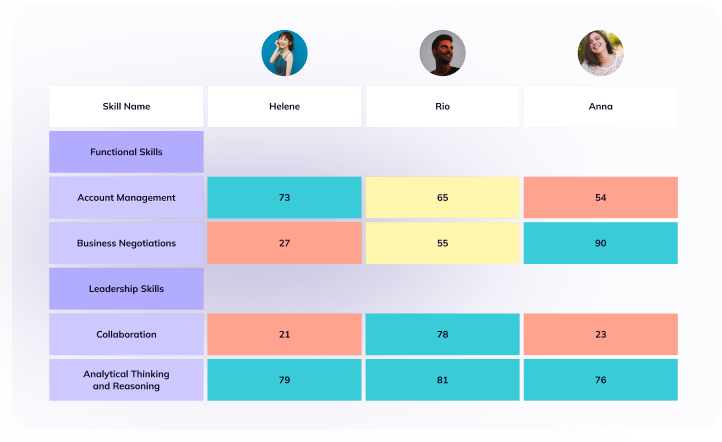Making the decision to invest in a new skilling technology holds significant weight for any organization. Similar to other crucial purchases, garnering support from decision-makers poses a challenge. So, how can you sway their opinion?
As a learning and development (L&D) professional, you might be exploring the potential advantages of implementing new skilling software within your company. However, it appears that your boss isn't entirely enthusiastic about the concept. Persuading executives at the senior level, particularly in the realm of adopting new software, can be a formidable undertaking. If your company already operates a traditional training program for learning new skills, your team lead or department head may question the necessity of integrating a new technology.
Here we have outlined how you can put together a strong and compelling business case for investment in skilling technology.
Challenges of Creating a Business Case
Creating a business case for skilling technology investment can be challenging due to various factors.
Here are some common challenges:

-
Quantifying intangible benefits: Skilling technology often provides intangible benefits such as improved employee morale, increased job satisfaction, and enhanced collaboration. Quantifying these benefits can be challenging but is crucial for a compelling technology business case.
-
Demonstrating return on investment (ROI): Showcasing a clear and measurable ROI is essential. Calculating the impact of skilling technology on key performance indicators (KPIs) like employee productivity or employee retention requires careful data collection and analysis.
-
Addressing upfront costs: Skilling technology implementation involves upfront costs, including software licenses and training. Convincing all the stakeholders to see beyond these initial expenses can be a hurdle.
-
Overcoming resistance to change: Employees and leadership may resist adopting new technology due to a fear of change. Building a business case that addresses and mitigates this resistance is crucial.
-
Aligning with organizational goals: Ensuring that the new skilling technology aligns with the organization's goals can be challenging. The business case must show how the investment contributes to achieving broader business outcomes.
To tackle these challenges, it is essential to develop a thorough and meticulously organized business case. This proposal should highlight the strategic significance, concrete advantages, and how the suggested skilling technology aligns with the overarching goals of the organization.
Importance of Leadership and Stakeholder Buy-In
Obtaining backing from stakeholders is crucial in this undertaking. According to a study, 19% of L&D practitioners face challenges in gaining approval or support from leadership for their initiatives, leading to obstacles in employees’ skill development. These steps will help you in preparing a robust business case:
Step 1: Identify decision-makers and key stakeholders
Identifying stakeholders is vital, including decision-makers like senior leaders, HR leaders, managers, administrators, designers, subject matter experts, technical support, and end users. While many stakeholders may already recognize the importance of skilling software, some may need clarification on its benefits. Demonstrating these advantages can help them understand why endorsing the technology is essential for the organization.
Step 2: Communicate how the technology can address stakeholders’ pain points
To increase chances of stakeholder support, ask yourself a key question: What challenges are stakeholders facing that skilling technology could address? Initiate productive discussions to understand specific issues your stakeholders want a new skilling technology to tackle. Whether it's inflexibility, administrative hassles, or time constraints, identifying precise pain points can garner their support.
Skilling technology isn't just for organizing employee learning; it offers additional benefits. Highlight its capacity to monitor employee engagement and generate detailed reports. Using these insights, stakeholders can make informed decisions.
Disprz provides an intuitive analytics dashboard to identify employees’ skill gaps to deliver targeted learning. You can track the training and development needs of your employees by having complete visibility into learning analytics.
Figure 1: Analytics to Identify Skill Gap
Step 3: The business rationale for investing in skilling technology
Inform your leaders that skilling software aligns with broader business goals. A skilled workforce is more adept at handling evolving job requirements, leading to increased organizational productivity and efficiency.
-
Skilling technology ensures that employees get equipped with the necessary technical skills, making the organization more adaptable to technological advancements. According to Linkedin’s 2023 Workplace Learning Report, skill sets needed for jobs have changed by almost 25% since 2015. Also, by 2027, this number is expected to double.
-
A skilled workforce is better equipped to meet customer needs. Skilling technology eventually enhances customer satisfaction by ensuring that employees have the right knowledge and skill-set to meet customer demands. According to an IBM research, there is a 16% increase in customer satisfaction with companies utilizing corporate learning technology.
Step 4: Develop a comprehensive implementation plan
Build and showcase a skilling technology implementation plan:
-
Form a team: Establish a team with well-defined roles. The team must ensure accountability, effective communication, and mutual understanding.
-
List your objectives: Outline the objectives your organization aims to accomplish through the implementation.
-
Determine the systems for integration: Create an integration plan that aligns with the objectives.
-
Document the smallest of details: Mention the timeline, scope, and priorities (if any) in the business plan.
Key Tips for a Successful Business Case
When crafting a business case for learning and development, ensure each component contributes significantly to building a compelling argument. Incorporate the elements below to thoroughly cover all aspects and dispel any potential doubts.

-
Identify your organization's current challenges. It could be high costs related to traditional training or the potential risks of lower satisfaction from inadequate training initiatives. Once these challenges are identified, it becomes easier to showcase how skilling software can effectively address and resolve them.
-
Emphasize business value over product features. Instead of fixating on the details of skilling software features, concentrate on how they contribute to business value. L&D leaders often err by overly highlighting features, but the essence lies in the business impact these features deliver. Translate features into specific elements that generate value for the business, shifting the focus from technology to business impact.
-
Anticipate and tackle stakeholder concerns proactively. Given the likelihood of opposition, identify potential reservations beforehand. Prepare a list of objections to skilling software, providing corresponding answers. For instance, if you are unsure about securing investment in a mobile learning tool, highlight its user-friendly features over alternatives like plug-ins or upgrades.
-
Support your arguments with verified data and facts. Strengthen your business case by incorporating both company-specific and industry-specific data in your proposal. Utilizing data will effectively demonstrate the business value of skilling technology, enhancing your ability to persuade leadership towards making the investment.
How Skilling Technology Aligns with the Overall Organizational Strategy?
Finally, inform the leadership how skilling technology aligns with broader business goals to garner support.
- Highlight the company's overall objectives, and emphasize how skilling technology would align and support the goals.
- Provide a detailed overview of the skilling technology investment and potential impact on the workforce. Articulate how this investment would be a strategic enabler for achieving business goals.
Disprz helps you transform skilling investment into a strategic asset. You can track each of your employee's skilling progress to meet the business needs.
Figure 2: Measure the Impact of Skilling Investment
-
Show a clear connection between skilling initiatives and KPIs that matter to the leadership. Prove how improved skills would contribute to organizational success
Conclusion
Implementing modern skilling technology is an effective means of training and empowering your workforce. Skilling technologies contribute to reducing attrition, supporting business growth, enhancing new-hire performance, and preparing teams for upcoming projects. However, it's crucial to build a compelling business case to secure support and funding from decision-makers. Initiating conversations about employee upskilling and reskilling is not just necessary but a strategic imperative for today's workforce.
Recognizing the value of improved skills in project readiness and business competitiveness allows organizations to pave the way for higher ROI. Embark on a journey of continual improvement through ongoing dialogue, thoughtful analysis, and proactive upskilling programs to keep your business ahead of the curve.
Download the purple paper now to get detailed insights on creating a compelling business case for investment in skilling technology. Discover key tips, cost saving advice, and ROI analysis examples to build a successful business case.









